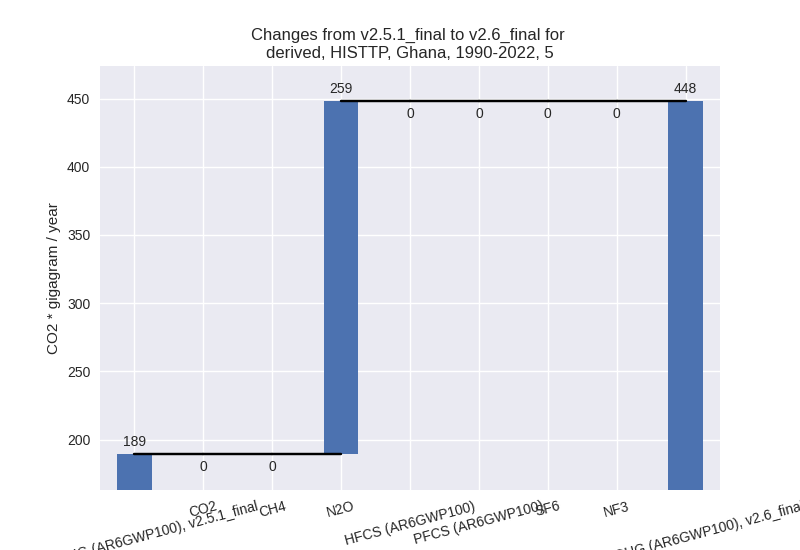Changes in PRIMAP-hist v2.6_final compared to v2.5.1_final for Ghana
2024-09-24
Johannes Gütschow
Change analysis for Ghana for PRIMAP-hist v2.6_final compared to v2.5.1_final
Overview over emissions by sector and gas
The following figures show the aggregate national total emissions excluding LULUCF AR6GWP100 for the country reported priority scenario. The dotted linesshow the v2.5.1_final data.
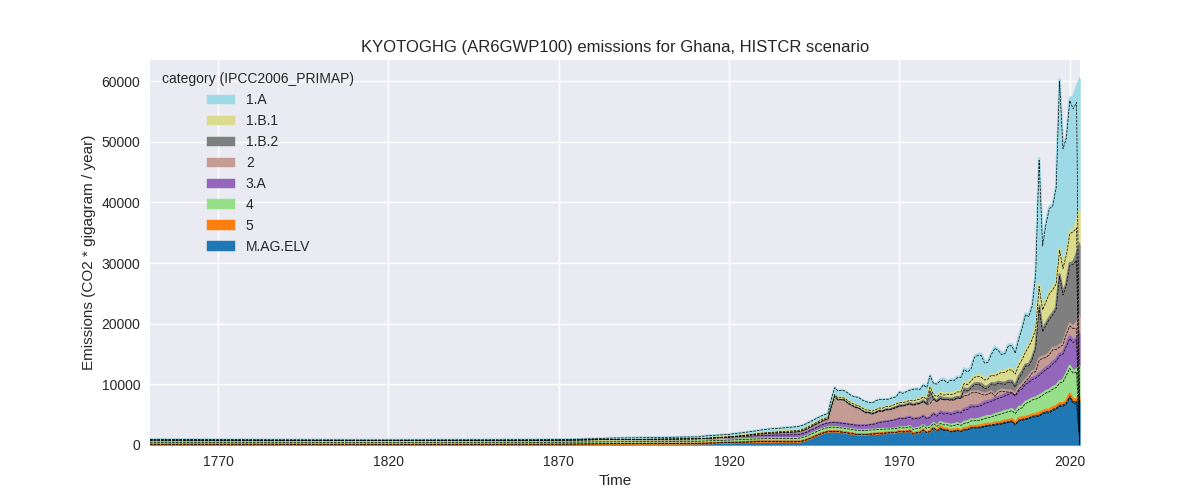
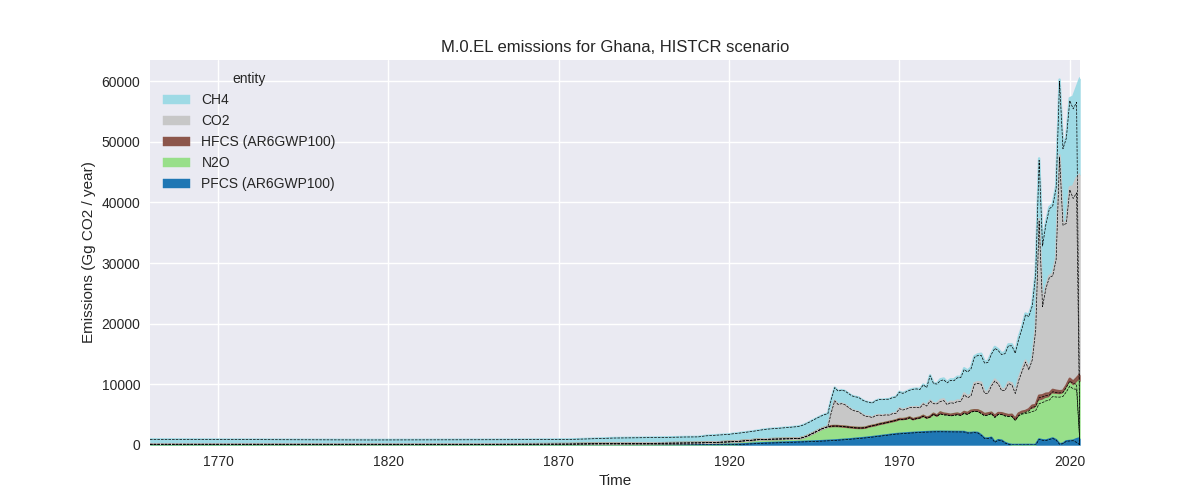
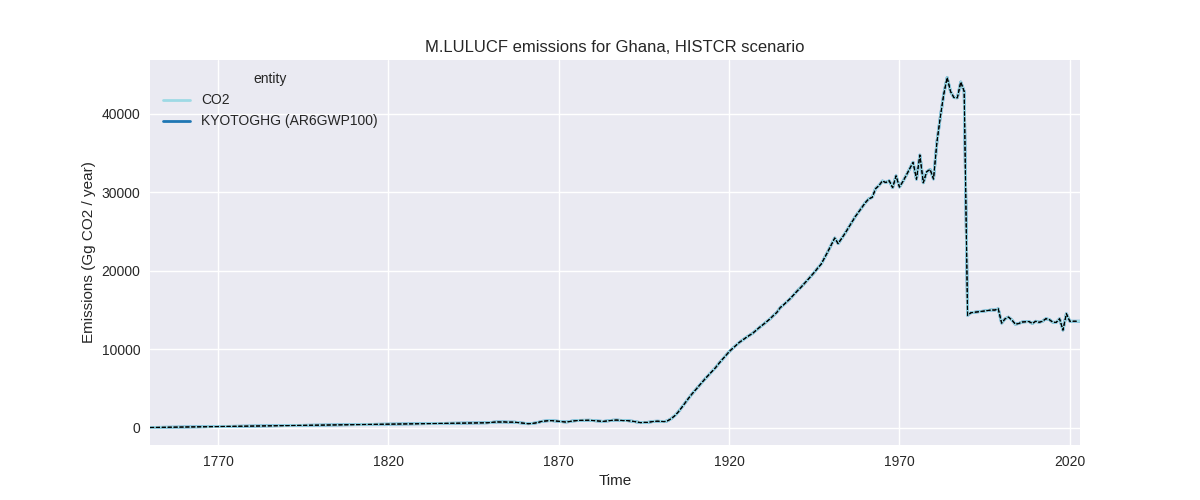
The following figures show the aggregate national total emissions excluding LULUCF AR6GWP100 for the third party priority scenario. The dotted linesshow the v2.5.1_final data.
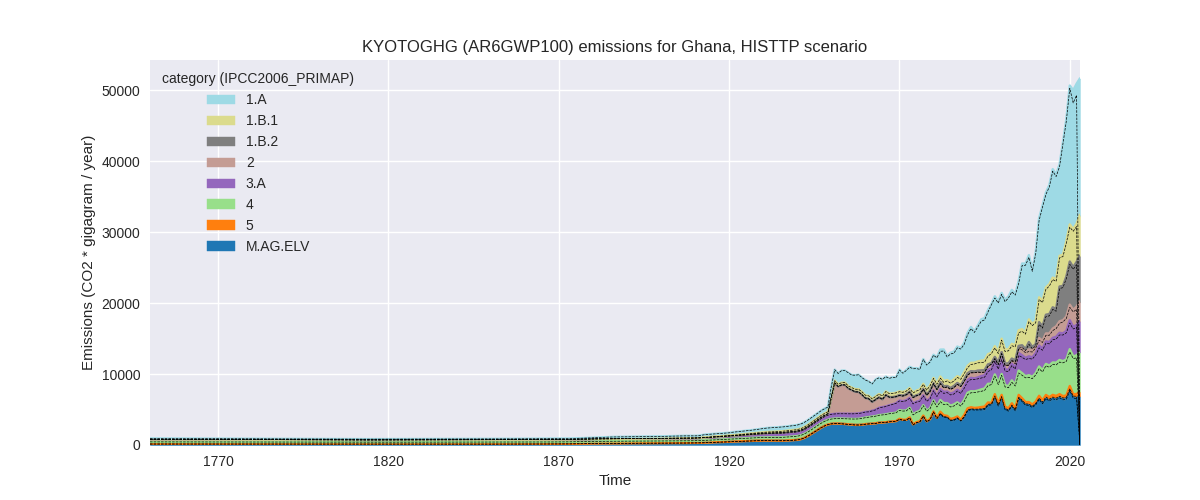
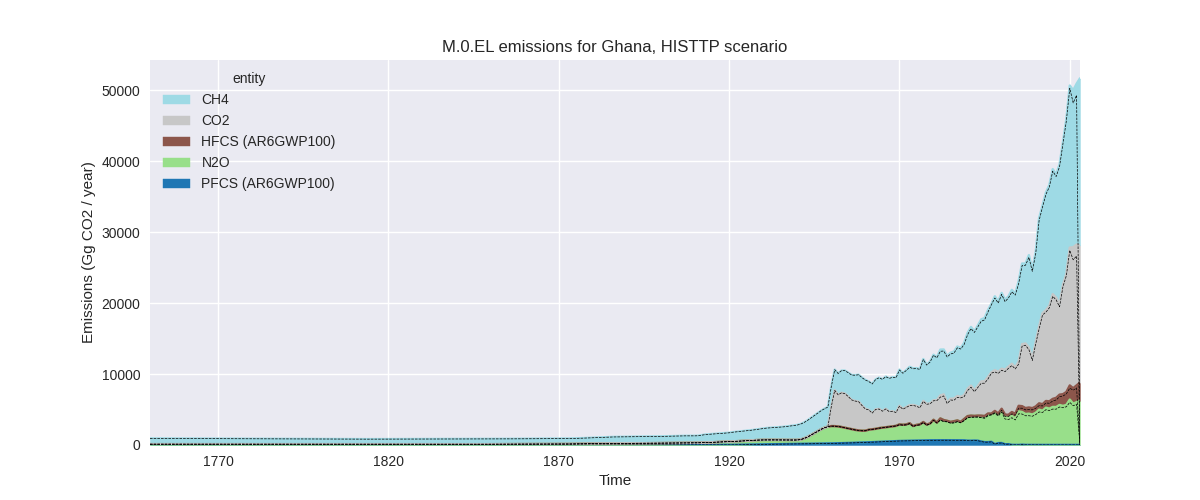
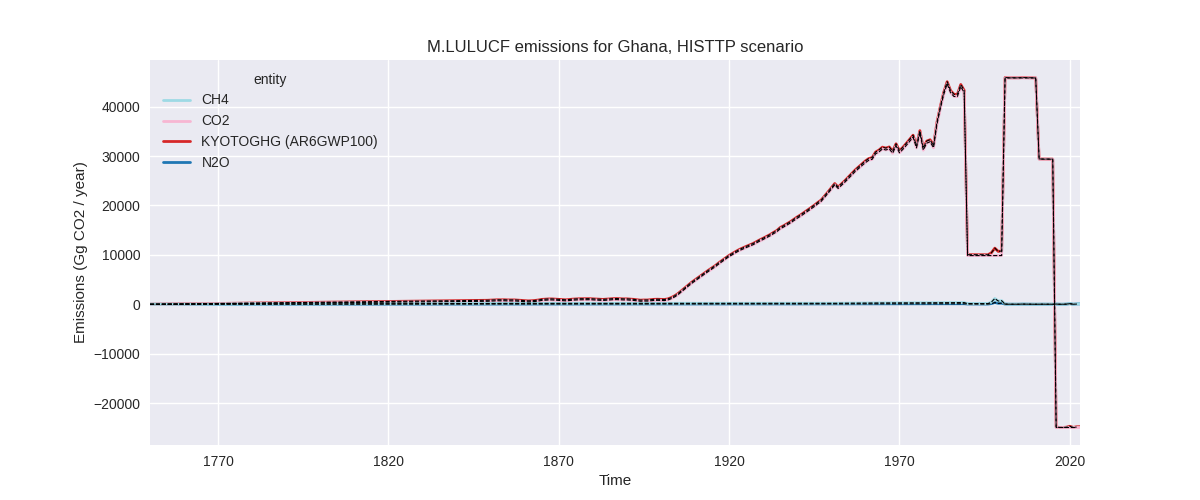
Overview over changes
In the country reported priority scenario we have the following changes for aggregate Kyoto GHG and national total emissions excluding LULUCF (M.0.EL):
- Emissions in 2022 have changed by 4.3%% (2430.96 Gg CO2 / year)
- Emissions in 1990-2022 have changed by 1.4%% (376.06 Gg CO2 / year)
In the third party priority scenario we have the following changes for aggregate Kyoto GHG and national total emissions excluding LULUCF (M.0.EL):
- Emissions in 2022 have changed by 3.3%% (1621.04 Gg CO2 / year)
- Emissions in 1990-2022 have changed by 1.2%% (342.37 Gg CO2 / year)
Most important changes per scenario and time frame
In the country reported priority scenario the following sector-gas combinations have the highest absolute impact on national total KyotoGHG (AR6GWP100) emissions in 2022 (top 5):
- 1: 1.A, CO2 with 1419.04 Gg CO2 / year (7.1%)
- 2: 2, PFCS (AR6GWP100) with 521.26 Gg CO2 / year (120.9%)
- 3: 5, N2O with 315.02 Gg CO2 / year (96.0%)
- 4: 2, HFCS (AR6GWP100) with 134.33 Gg CO2 / year (16.6%)
- 5: 4, N2O with 30.50 Gg CO2 / year (4.8%)
In the country reported priority scenario the following sector-gas combinations have the highest absolute impact on national total KyotoGHG (AR6GWP100) emissions in 1990-2022 (top 5):
- 1: 5, N2O with 258.82 Gg CO2 / year (136.8%)
- 2: 1.A, CO2 with 94.28 Gg CO2 / year (1.1%)
- 3: 2, PFCS (AR6GWP100) with 15.80 Gg CO2 / year (2.2%)
- 4: 2, HFCS (AR6GWP100) with 4.07 Gg CO2 / year (1.1%)
- 5: 4, N2O with 2.39 Gg CO2 / year (0.5%)
In the third party priority scenario the following sector-gas combinations have the highest absolute impact on national total KyotoGHG (AR6GWP100) emissions in 2022 (top 5):
- 1: 1.A, CO2 with 1238.68 Gg CO2 / year (7.1%)
- 2: 5, N2O with 315.02 Gg CO2 / year (96.0%)
- 3: 2, HFCS (AR6GWP100) with 34.14 Gg CO2 / year (1.5%)
- 4: 4, N2O with 15.73 Gg CO2 / year (4.4%)
- 5: 4, CH4 with 9.56 Gg CO2 / year (0.2%)
In the third party priority scenario the following sector-gas combinations have the highest absolute impact on national total KyotoGHG (AR6GWP100) emissions in 1990-2022 (top 5):
- 1: 5, N2O with 258.82 Gg CO2 / year (136.8%)
- 2: 1.A, CO2 with 82.29 Gg CO2 / year (0.9%)
- 3: 4, CH4 with -2.47 Gg CO2 / year (-0.1%)
- 4: 4, N2O with 2.16 Gg CO2 / year (1.0%)
- 5: 2, HFCS (AR6GWP100) with 1.03 Gg CO2 / year (0.1%)
Notes on data changes
Here we list notes explaining important emissions changes for the country. ’' means that the following text only applies to the TP time series, while means that it only applies to the CR scenario. Otherwise the note applies to both scenarios.
- 2022 changes for energy CO2 due to updated EI data.
- Changes in sectors 4 and 5 are due to the removal of FAOSTAT data.
- Higher 2022 PFC emissions in the CR scenario are due to the shorter extrapolation trend period.
Changes by sector and gas
For each scenario and time frame the changes are displayed for all individual sectors and all individual gases. In the sector plot we use aggregate Kyoto GHGs in AR6GWP100. In the gas plot we usenational total emissions without LULUCF. ## country reported scenario
2022
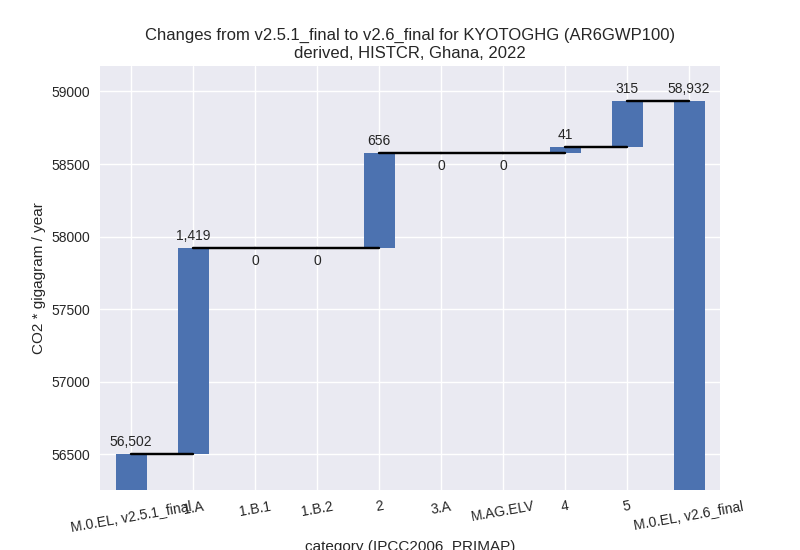
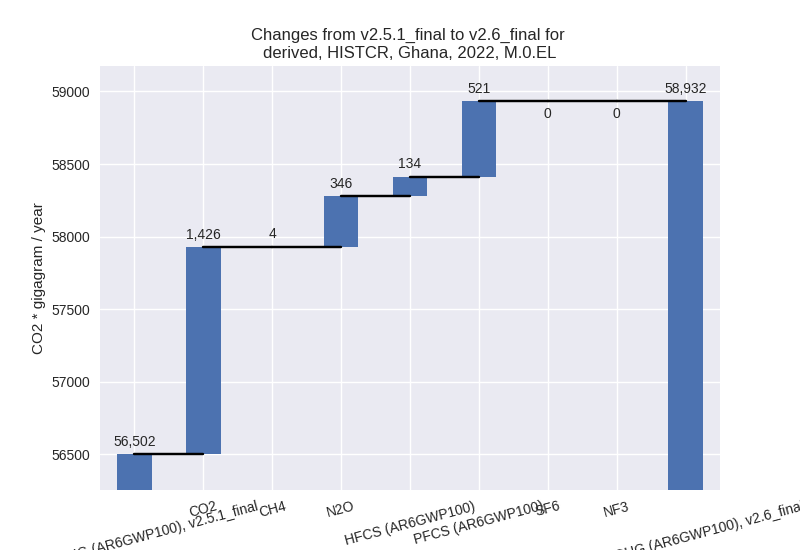
1990-2022
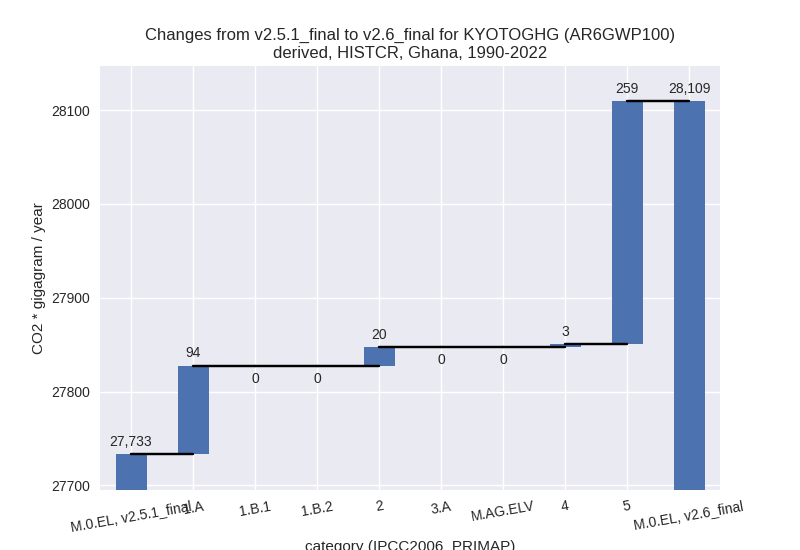
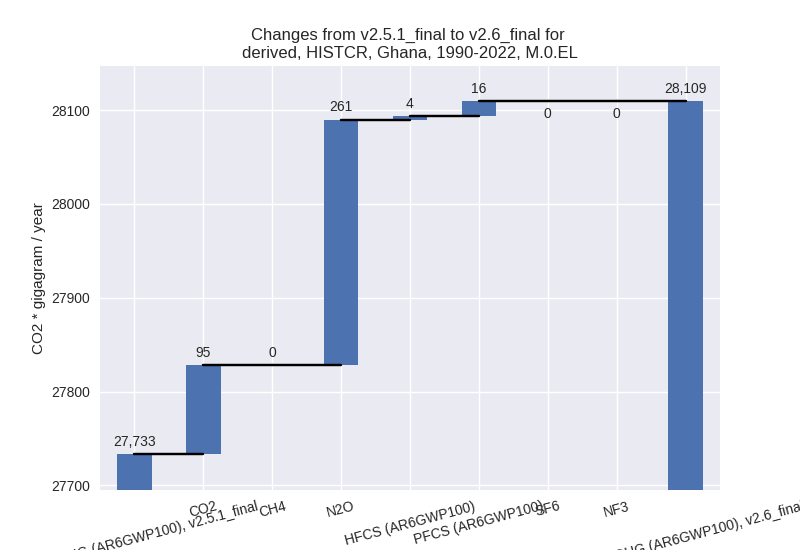
third party scenario
2022

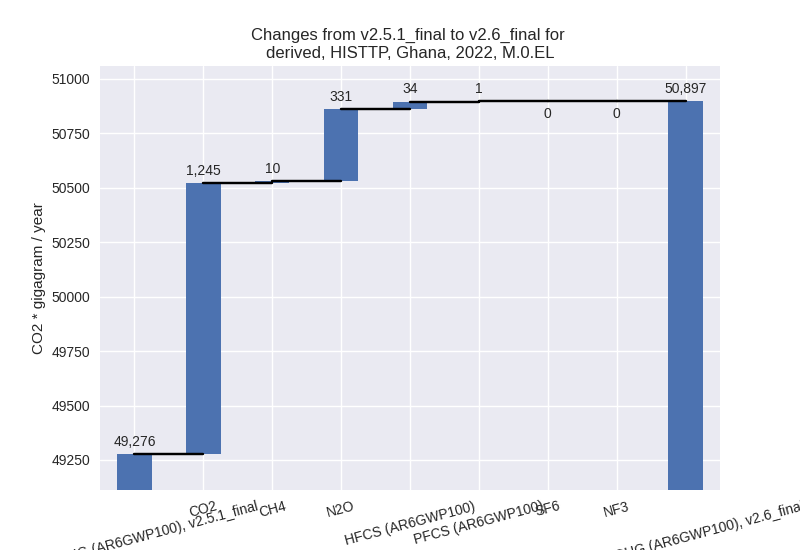
1990-2022
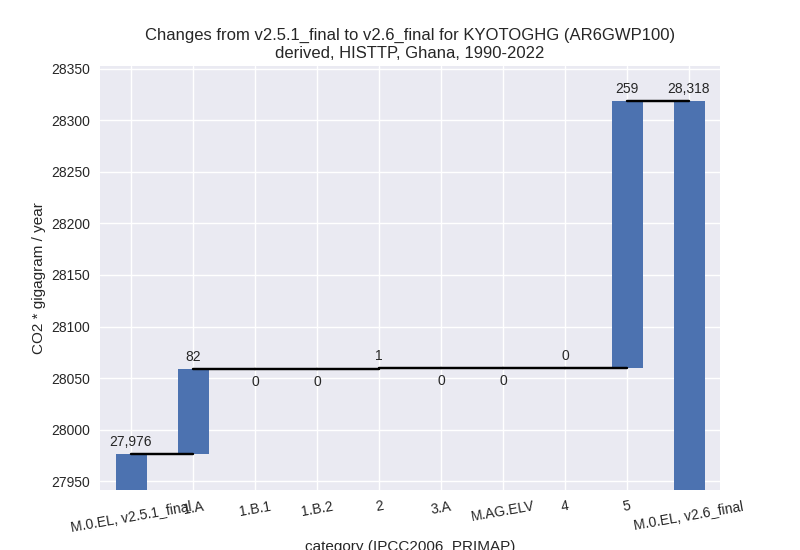
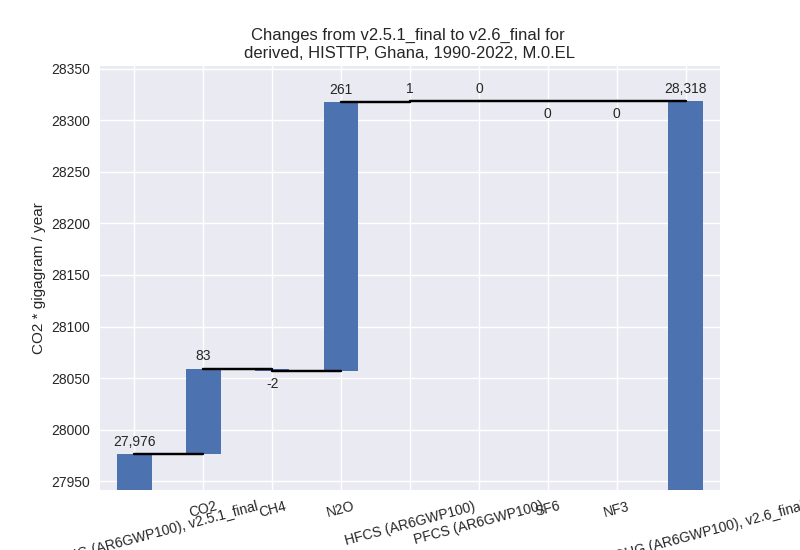
Detailed changes for the scenarios:
country reported scenario (HISTCR):
Most important changes per time frame
For 2022 the following sector-gas combinations have the highest absolute impact on national total KyotoGHG (AR6GWP100) emissions in 2022 (top 5):
- 1: 1.A, CO2 with 1419.04 Gg CO2 / year (7.1%)
- 2: 2, PFCS (AR6GWP100) with 521.26 Gg CO2 / year (120.9%)
- 3: 5, N2O with 315.02 Gg CO2 / year (96.0%)
- 4: 2, HFCS (AR6GWP100) with 134.33 Gg CO2 / year (16.6%)
- 5: 4, N2O with 30.50 Gg CO2 / year (4.8%)
For 1990-2022 the following sector-gas combinations have the highest absolute impact on national total KyotoGHG (AR6GWP100) emissions in 1990-2022 (top 5):
- 1: 5, N2O with 258.82 Gg CO2 / year (136.8%)
- 2: 1.A, CO2 with 94.28 Gg CO2 / year (1.1%)
- 3: 2, PFCS (AR6GWP100) with 15.80 Gg CO2 / year (2.2%)
- 4: 2, HFCS (AR6GWP100) with 4.07 Gg CO2 / year (1.1%)
- 5: 4, N2O with 2.39 Gg CO2 / year (0.5%)
Changes in the main sectors for aggregate KyotoGHG (AR6GWP100) are
- 1: Total sectoral emissions in 2022 are 38737.83 Gg
CO2 / year which is 65.7% of M.0.EL emissions. 2022 Emissions have
changed by 3.8% (1419.04 Gg CO2 /
year). 1990-2022 Emissions have changed by 0.6% (94.28 Gg CO2 / year). For 2022 the
changes per gas
are:
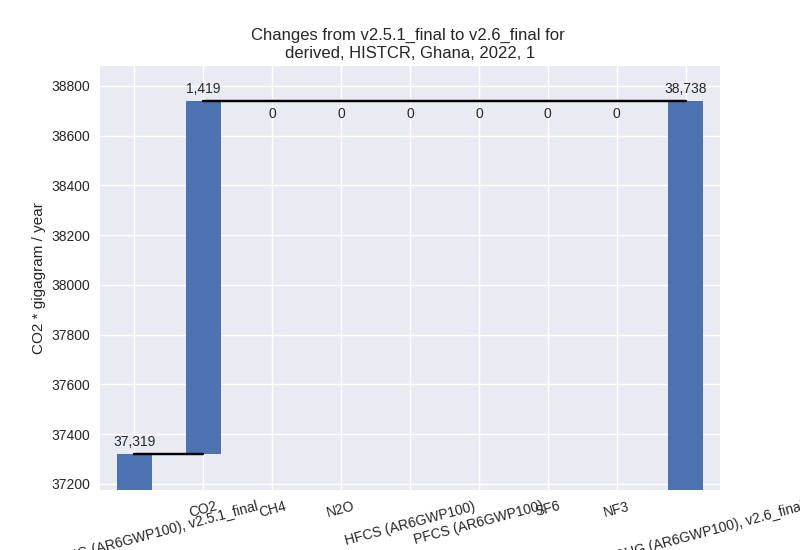
The changes come from the following subsectors:- 1.A: Total sectoral emissions in 2022 are 22141.54
Gg CO2 / year which is 57.2% of category 1 emissions. 2022 Emissions
have changed by 6.8% (1419.04 Gg CO2
/ year). 1990-2022 Emissions have changed by 1.0% (94.28 Gg CO2 / year). For 2022 the
changes per gas
are:
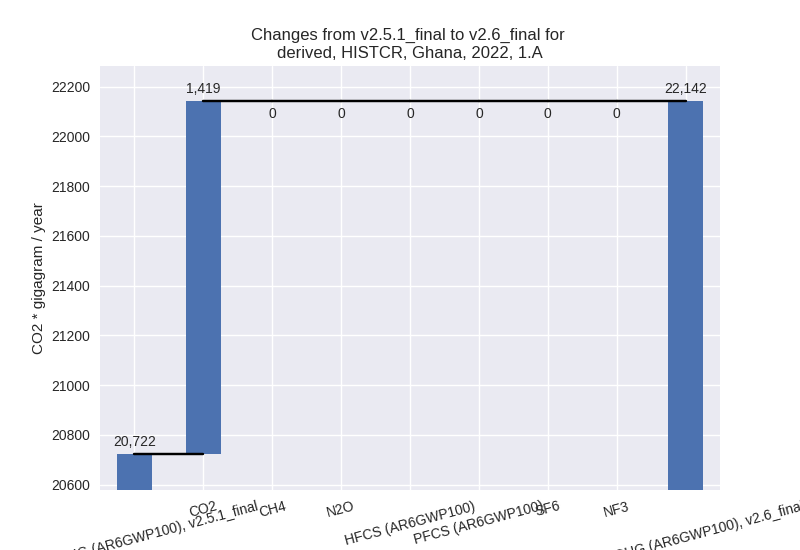
There is no subsector information available in PRIMAP-hist. - 1.B.1: Total sectoral emissions in 2022 are 5360.60 Gg CO2 / year which is 13.8% of category 1 emissions. 2022 Emissions have changed by 0.0% (0.00 Gg CO2 / year). 1990-2022 Emissions have changed by 0.0% (0.00 Gg CO2 / year).
- 1.B.2: Total sectoral emissions in 2022 are 11235.69 Gg CO2 / year which is 29.0% of category 1 emissions. 2022 Emissions have changed by 0.0% (0.00 Gg CO2 / year). 1990-2022 Emissions have changed by 0.0% (0.00 Gg CO2 / year).
- 1.A: Total sectoral emissions in 2022 are 22141.54
Gg CO2 / year which is 57.2% of category 1 emissions. 2022 Emissions
have changed by 6.8% (1419.04 Gg CO2
/ year). 1990-2022 Emissions have changed by 1.0% (94.28 Gg CO2 / year). For 2022 the
changes per gas
are:
- 2: Total sectoral emissions in 2022 are 2571.35 Gg
CO2 / year which is 4.4% of M.0.EL emissions. 2022 Emissions have
changed by 34.2% (655.59 Gg CO2 /
year). 1990-2022 Emissions have changed by 1.4% (19.87 Gg CO2 / year). For 2022 the
changes per gas
are:
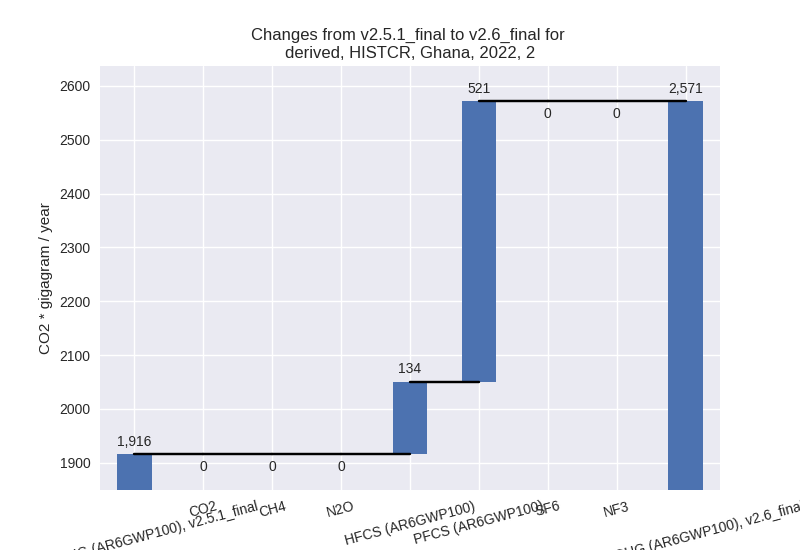
- M.AG: Total sectoral emissions in 2022 are 12147.27 Gg CO2 / year which is 20.6% of M.0.EL emissions. 2022 Emissions have changed by 0.0% (0.00 Gg CO2 / year). 1990-2022 Emissions have changed by 0.0% (0.00 Gg CO2 / year).
- 4: Total sectoral emissions in 2022 are 4832.82 Gg CO2 / year which is 8.2% of M.0.EL emissions. 2022 Emissions have changed by 0.9% (41.31 Gg CO2 / year). 1990-2022 Emissions have changed by 0.1% (3.09 Gg CO2 / year).
- 5: Total sectoral emissions in 2022 are 643.22 Gg
CO2 / year which is 1.1% of M.0.EL emissions. 2022 Emissions have
changed by 96.0% (315.02 Gg CO2 /
year). 1990-2022 Emissions have changed by 136.8% (258.82 Gg CO2 / year). For 2022
the changes per gas
are:
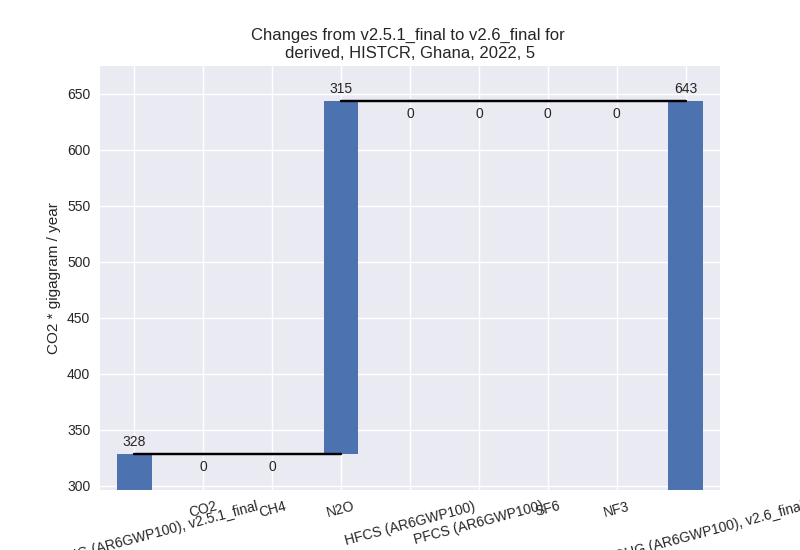
For 1990-2022 the changes per gas are:
third party scenario (HISTTP):
Most important changes per time frame
For 2022 the following sector-gas combinations have the highest absolute impact on national total KyotoGHG (AR6GWP100) emissions in 2022 (top 5):
- 1: 1.A, CO2 with 1238.68 Gg CO2 / year (7.1%)
- 2: 5, N2O with 315.02 Gg CO2 / year (96.0%)
- 3: 2, HFCS (AR6GWP100) with 34.14 Gg CO2 / year (1.5%)
- 4: 4, N2O with 15.73 Gg CO2 / year (4.4%)
- 5: 4, CH4 with 9.56 Gg CO2 / year (0.2%)
For 1990-2022 the following sector-gas combinations have the highest absolute impact on national total KyotoGHG (AR6GWP100) emissions in 1990-2022 (top 5):
- 1: 5, N2O with 258.82 Gg CO2 / year (136.8%)
- 2: 1.A, CO2 with 82.29 Gg CO2 / year (0.9%)
- 3: 4, CH4 with -2.47 Gg CO2 / year (-0.1%)
- 4: 4, N2O with 2.16 Gg CO2 / year (1.0%)
- 5: 2, HFCS (AR6GWP100) with 1.03 Gg CO2 / year (0.1%)
Changes in the main sectors for aggregate KyotoGHG (AR6GWP100) are
- 1: Total sectoral emissions in 2022 are 31398.42 Gg
CO2 / year which is 61.7% of M.0.EL emissions. 2022 Emissions have
changed by 4.1% (1238.68 Gg CO2 /
year). 1990-2022 Emissions have changed by 0.6% (82.29 Gg CO2 / year). For 2022 the
changes per gas
are:
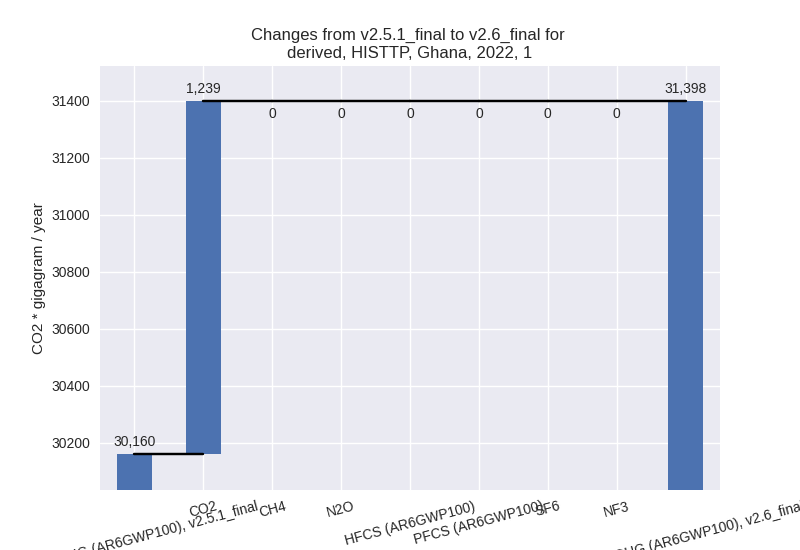
The changes come from the following subsectors:- 1.A: Total sectoral emissions in 2022 are 19743.75
Gg CO2 / year which is 62.9% of category 1 emissions. 2022 Emissions
have changed by 6.7% (1238.68 Gg CO2
/ year). 1990-2022 Emissions have changed by 0.8% (82.29 Gg CO2 / year). For 2022 the
changes per gas
are:
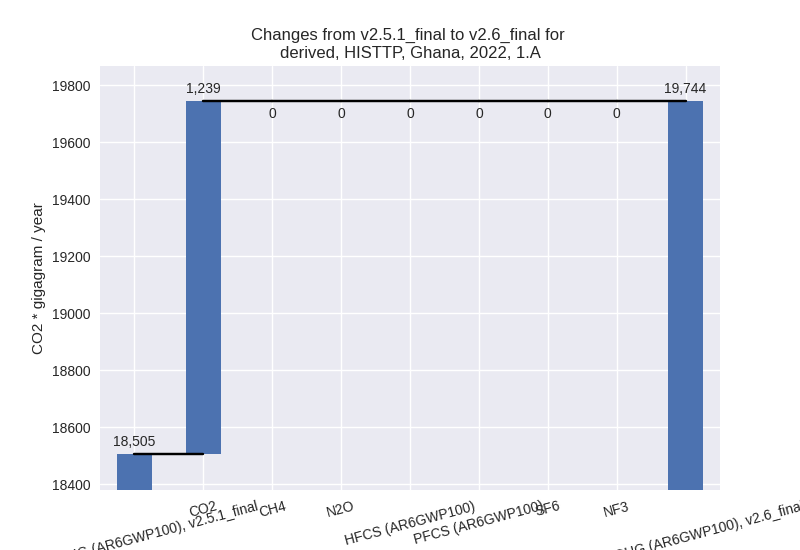
There is no subsector information available in PRIMAP-hist. - 1.B.1: Total sectoral emissions in 2022 are 5360.60 Gg CO2 / year which is 17.1% of category 1 emissions. 2022 Emissions have changed by 0.0% (0.00 Gg CO2 / year). 1990-2022 Emissions have changed by 0.0% (0.00 Gg CO2 / year).
- 1.B.2: Total sectoral emissions in 2022 are 6294.08 Gg CO2 / year which is 20.0% of category 1 emissions. 2022 Emissions have changed by 0.0% (0.00 Gg CO2 / year). 1990-2022 Emissions have changed by 0.0% (0.00 Gg CO2 / year).
- 1.A: Total sectoral emissions in 2022 are 19743.75
Gg CO2 / year which is 62.9% of category 1 emissions. 2022 Emissions
have changed by 6.7% (1238.68 Gg CO2
/ year). 1990-2022 Emissions have changed by 0.8% (82.29 Gg CO2 / year). For 2022 the
changes per gas
are:
- 2: Total sectoral emissions in 2022 are 2584.98 Gg CO2 / year which is 5.1% of M.0.EL emissions. 2022 Emissions have changed by 1.4% (35.56 Gg CO2 / year). 1990-2022 Emissions have changed by 0.1% (1.08 Gg CO2 / year).
- M.AG: Total sectoral emissions in 2022 are 10824.85 Gg CO2 / year which is 21.3% of M.0.EL emissions. 2022 Emissions have changed by 0.0% (0.00 Gg CO2 / year). 1990-2022 Emissions have changed by 0.0% (0.00 Gg CO2 / year).
- 4: Total sectoral emissions in 2022 are 5445.92 Gg CO2 / year which is 10.7% of M.0.EL emissions. 2022 Emissions have changed by 0.6% (31.78 Gg CO2 / year). 1990-2022 Emissions have changed by 0.0% (0.18 Gg CO2 / year).
- 5: Total sectoral emissions in 2022 are 643.22 Gg
CO2 / year which is 1.3% of M.0.EL emissions. 2022 Emissions have
changed by 96.0% (315.02 Gg CO2 /
year). 1990-2022 Emissions have changed by 136.8% (258.82 Gg CO2 / year). For 2022
the changes per gas
are:
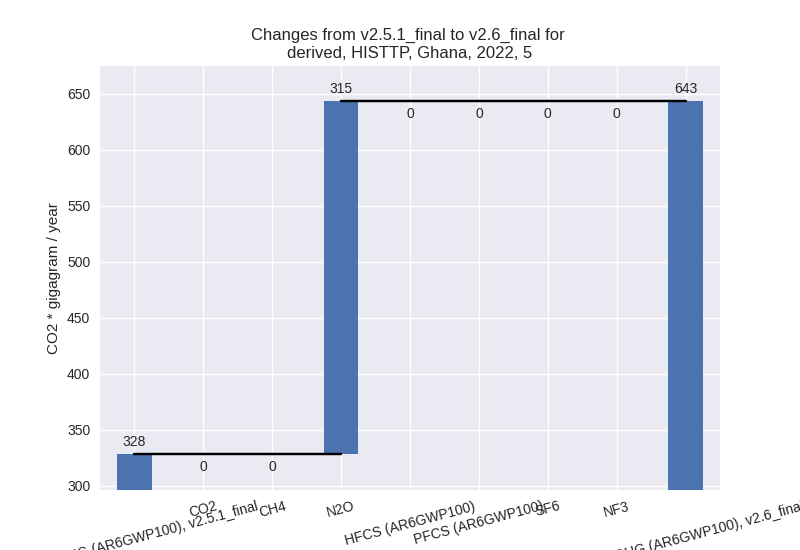
For 1990-2022 the changes per gas are: